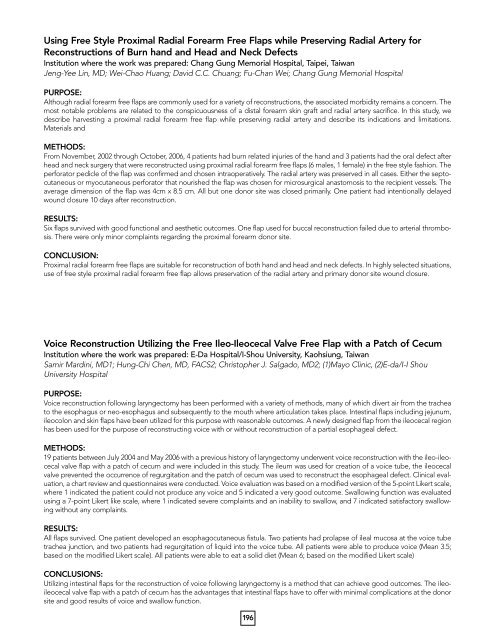Floor plan - 2013 Annual Meeting - American Association for Hand ...
Floor plan - 2013 Annual Meeting - American Association for Hand ...
Floor plan - 2013 Annual Meeting - American Association for Hand ...
Create successful ePaper yourself
Turn your PDF publications into a flip-book with our unique Google optimized e-Paper software.
Using Free Style Proximal Radial Forearm Free Flaps while Preserving Radial Artery <strong>for</strong><br />
Reconstructions of Burn hand and Head and Neck Defects<br />
Institution where the work was prepared: Chang Gung Memorial Hospital, Taipei, Taiwan<br />
Jeng-Yee Lin, MD; Wei-Chao Huang; David C.C. Chuang; Fu-Chan Wei; Chang Gung Memorial Hospital<br />
PURPOSE:<br />
Although radial <strong>for</strong>earm free flaps are commonly used <strong>for</strong> a variety of reconstructions, the associated morbidity remains a concern. The<br />
most notable problems are related to the conspicuousness of a distal <strong>for</strong>earm skin graft and radial artery sacrifice. In this study, we<br />
describe harvesting a proximal radial <strong>for</strong>earm free flap while preserving radial artery and describe its indications and limitations.<br />
Materials and<br />
METHODS:<br />
From November, 2002 through October, 2006, 4 patients had burn related injuries of the hand and 3 patients had the oral defect after<br />
head and neck surgery that were reconstructed using proximal radial <strong>for</strong>earm free flaps (6 males, 1 female) in the free style fashion. The<br />
per<strong>for</strong>ator pedicle of the flap was confirmed and chosen intraoperatively. The radial artery was preserved in all cases. Either the septocutaneous<br />
or myocutaneous per<strong>for</strong>ator that nourished the flap was chosen <strong>for</strong> microsurgical anastomosis to the recipient vessels. The<br />
average dimension of the flap was 4cm x 8.5 cm. All but one donor site was closed primarily. One patient had intentionally delayed<br />
wound closure 10 days after reconstruction.<br />
RESULTS:<br />
Six flaps survived with good functional and aesthetic outcomes. One flap used <strong>for</strong> buccal reconstruction failed due to arterial thrombosis.<br />
There were only minor complaints regarding the proximal <strong>for</strong>earm donor site.<br />
CONCLUSION:<br />
Proximal radial <strong>for</strong>earm free flaps are suitable <strong>for</strong> reconstruction of both hand and head and neck defects. In highly selected situations,<br />
use of free style proximal radial <strong>for</strong>earm free flap allows preservation of the radial artery and primary donor site wound closure.<br />
Voice Reconstruction Utilizing the Free Ileo-Ileocecal Valve Free Flap with a Patch of Cecum<br />
Institution where the work was prepared: E-Da Hospital/I-Shou University, Kaohsiung, Taiwan<br />
Samir Mardini, MD1; Hung-Chi Chen, MD, FACS2; Christopher J. Salgado, MD2; (1)Mayo Clinic, (2)E-da/I-I Shou<br />
University Hospital<br />
PURPOSE:<br />
Voice reconstruction following laryngectomy has been per<strong>for</strong>med with a variety of methods, many of which divert air from the trachea<br />
to the esophagus or neo-esophagus and subsequently to the mouth where articulation takes place. Intestinal flaps including jejunum,<br />
ileocolon and skin flaps have been utilized <strong>for</strong> this purpose with reasonable outcomes. A newly designed flap from the ileocecal region<br />
has been used <strong>for</strong> the purpose of reconstructing voice with or without reconstruction of a partial esophageal defect.<br />
METHODS:<br />
19 patients between July 2004 and May 2006 with a previous history of laryngectomy underwent voice reconstruction with the ileo-ileocecal<br />
valve flap with a patch of cecum and were included in this study. The ileum was used <strong>for</strong> creation of a voice tube, the ileocecal<br />
valve prevented the occurrence of regurgitation and the patch of cecum was used to reconstruct the esophageal defect. Clinical evaluation,<br />
a chart review and questionnaires were conducted. Voice evaluation was based on a modified version of the 5-point Likert scale,<br />
where 1 indicated the patient could not produce any voice and 5 indicated a very good outcome. Swallowing function was evaluated<br />
using a 7-point Likert like scale, where 1 indicated severe complaints and an inability to swallow, and 7 indicated satisfactory swallowing<br />
without any complaints.<br />
RESULTS:<br />
All flaps survived. One patient developed an esophagocutaneous fistula. Two patients had prolapse of ileal mucosa at the voice tube<br />
trachea junction, and two patients had regurgitation of liquid into the voice tube. All patients were able to produce voice (Mean 3.5;<br />
based on the modified Likert scale). All patients were able to eat a solid diet (Mean 6; based on the modified Likert scale)<br />
CONCLUSIONS:<br />
Utilizing intestinal flaps <strong>for</strong> the reconstruction of voice following laryngectomy is a method that can achieve good outcomes. The ileoileocecal<br />
valve flap with a patch of cecum has the advantages that intestinal flaps have to offer with minimal complications at the donor<br />
site and good results of voice and swallow function.<br />
196



